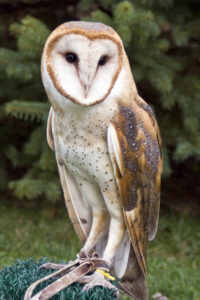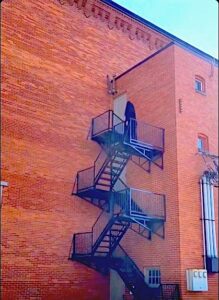Bugs are sure to light up night

Photo by Terry Priest Pictured is an adult firefly.
It’s the last day of June and I’m standing under the overhang on my back deck protected from the last drips of a rainstorm. It’s past nine o’clock but not quite dark yet. But the yard is starting to light up, one or two flashes at a time. It’s lightning bug season.
These flashing, nocturnal insects are as quintessential to the summer experience as long days, afternoon thunderstorms, and ice cream. On summer evenings, their glow approaches magical. Real life fairy lights in my own backyard.
Are They Fireflies or Lightning Bugs?
I use these two common names interchangeably (as you’ll see). Either common name works. Scientifically, these glowing insects are neither a fly nor a bug but a beetle in the family Lampyridae.
They go through four stages in their lifecycle – egg, larva, pupa, and adult. While the adult gets all the attention, they spend most of their life in the larva stage. Turn over a rotten log or push aside leaf litter in damp habitats and you might find a larva. Do this at night and you may see it glow. The larva of many firefly species light up, earning the nickname of “glow worm”.
This is a diverse family of beetles. Scientists estimate there are over 170 lightning bug species in North America and 2400 species worldwide. When watching at night, you may notice this diversity. Each species differs in the time they are active, habitat and location in that habitat, light color, and flashing pattern.
For example, the fireflies in my yard become active at sunset. My yard is a mix of trees, mowed and tall grass, shrubs, and other plants. The fireflies stay mostly in the low bushes and tall grass. And they flash a yellow-green light, one flash at a time, several seconds apart. Based on my reading, it is most likely a Common Eastern Firefly (Photinus pyralis).
But there are greenish, bluish, and white glows from different species. Some flash while flying. Some prefer trees, others fields. The most spectacular display I’ve witnessed are synchronous fireflies. In ways science has yet to figure out, they coordinate their flashing patterns to start and end at roughly the same time.
They were once thought to only live in the Smokey Mountains. But I have stood under canopy openings in both Allegheny National Forest and in Allegany State Park to see these fireflies. They are not precisely coordinated. It is more like camera flashes in a stadium or a wave of audience applause. Everything is dark. Then they start, each individual flashing 5 – 8 times, and then they stop and it’s dark again.
How and Why Do They Glow?
To be able to glow, the firefly’s abdomen is a little, bioluminescent chemistry lab. The chemical called luciferin and enzymes called luciferases are present. When mixed with oxygen, it produces a cold, rather than hot light. Fireflies regulate the flow of oxygen entering through breathing pores in their abdomen.
Lightning bugs have evolved this unique trait for communication – specifically, to attract a mate. The females, usually flightless, flash from lower perches. Males fly, sending out messages and responding to those who flash the same color and pattern.
But there are always exceptions in the natural world. There are firefly species active in the daytime, using smells, rather than light to attract a mate. Larva glow not to attract a mate but to deter predators. And then there’s a group of fireflies – the Photuris species – who’s females mimic the flashes of another species’ males. When the male approaches, she captures and eats them. This predation has a purpose. Many other fireflies produce toxins that make them distasteful to predators, Photuris species doesn’t. It acquires the toxins by eating other fireflies.
The magic of fireflies is also met with a good dose of nostalgia. I remember hot summer evenings running around my grandparents’ yard catching fireflies and putting them in jars. It seems like there were so many more when I was a kid. This is not just nostalgia and it’s not just me.
The International Union for Conservation of Nature found that one in three of the firefly species studied in North America may be at risk of extinction. But, for a much-loved insect, there is not a lot of research on fireflies and their populations to make determinations.
What scientists do know is the biggest threats to fireflies are habitat loss, light pollution, and pesticide use. The Xerces Society for Invertebrate Conservation at https://xerces.org/endangered-species/fireflies lists important things anyone can do to protect fireflies.
— Provide habitat! Set aside a part of your yard or garden where things can get a little wild.
— Avoid pesticide use, which can kill fireflies and their prey or degrade habitat.
— Turn off your outdoor lights at night, especially during the summer firefly season. · Contribute to our collective firefly knowledge by participating in a community science project. Find more information at https://xerces.org/endangered-species/fireflies/community-science
— Spread the word and let others know about fireflies and their needs.
But can you still catch fireflies?
Most sources say it’s OK as long as you are not squishing them. Practice catch and release. Don’t keep them longer than a day. If you are out at night looking for fireflies, you can cover your flashlight with a blue-colored film or thin paper.
Scientists believe fireflies don’t interpret blue light the same way they see other colors, so the light won’t disorient their flash patterns.
These summer insects are a magical, important creature we share the world with. Enjoy them!
Audubon Community Nature Center builds and nurtures connections between people and nature. ACNC is located just east of Route 62 between Warren and Jamestown. The trails are open from dawn to dusk and birds of prey can be viewed anytime the trails are open. The Nature Center is open from 10 a.m. until 4:30 p.m. daily except Sunday when it opens at 1 p.m. More information can be found online at auduboncnc.org or by calling (716) 569-2345.


